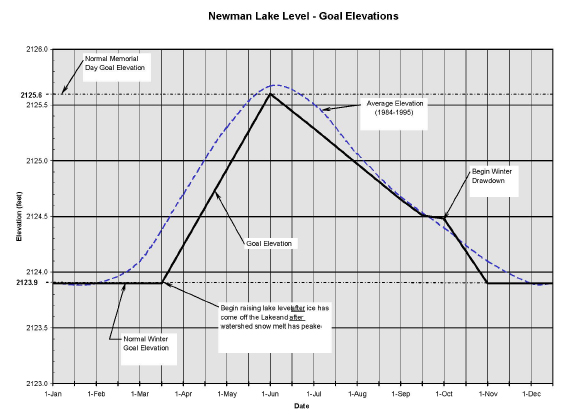NL Water Level
Why is Newman Lake’s Water Level Adjusted
Throughout the Year?
Lee Tate (2017 NLPOA Newsletter): Year-Round Resident – Peninsula
“If the water level was lower, would I lose my beach?”
“If the water level was lower, would I gain more beach?”
“If the water level remains constant, would I have fewer problems with
my dock and water line.”
“If the water was lower, would I still be able to launch my boat?”
These are all questions many year-round and summer residents ask. The lake level is affected by capacity of several components of the lake, not by some bureaucrat making uninformed decisions for us.
Here are the 5 principle components of flood control
• Water influent – water in from streams and underwater wells
• Water effluent – water out over the dam
• Dam capacity
• Ditch capacity
• Sump capacity
Influent is controlled by nature. It depends on soil saturation, rainfall, snowmelt, and weather (sunshine and wind effecting evaporation). As residents, we have essentially no control of influent to the lake.
Discharge of water from the lake is controlled by humans, by opening and closing of the gates at the dam. The human that controls the dam must consider the capacity of each of these components: the dam, the dike, the ditch, and the sump. Therefore, the water level of Newman Lake is mostly human controlled.
If the dike doesn’t fail, and holds the water in the lake, the gate at the dam determines the resulting water level. The water flowing over the weir at the gate will be determined by the influent rate. If the gate is not changed and there is no influent, there will be no effluent. However, the gate cannot allow more water out of the lake than the downstream components (ditch and sump) can accept.
The ditch has a flow capacity based on its size, length, and its condition. If it has filled in with plants or earthen materials that sluff off the side walls into the ditch (especially during high flows), or some obstruction has been placed in the ditch, the capacity is reduced. During spring runoff, influent can, and frequently does, exceed the capacity
of the ditch’s ability to carry it and the runoff from downstream fields (the South flats). The result is that both Starr Rd and the fields downstream can flood between the dam and the South bridge on Starr Rd. from water flow in excess of the capacity
of the ditch.
The other restriction to how much water can be discharged from the lake is the sump. Some of you may not know this, but all the water released out of Newman Lake flows over the gate at the dam, down the ditch, into the “sump”, which is just out of road sight south of Eller’s driveway. The sump sits over the Rathdrum Aquifer and water entering the sump simply seeps into the ground water at a very high rate and disappears.
The sump is the primary catch basin for sediment flowing down the ditch, and thus eventually plugs up with dirt, reducing its capacity to take the water that flows there. The sump needs to be scraped clean from silt every five years or so, for it to work
properly and infiltrate the water it receives.
If the dam lets out more water than the sump can take in, even if the ditch can deliver that much water to the sump, the land around the sump floods, and the top soil around the sump erodes into the sump, further plugging it and reducing capacity.
The result of all these capacity limitations is that during spring runoff, more water enters the lake than we can let out. The solution to this imbalance is either a much larger ditch and sump, costing us a lot of money in capital improvements, or a wiser
solution, temporarily storing the water in the lake until the runoff reduces its flow rate to the capacity limits of the ditch and sump. This is what we do at Newman Lake.
The difference between winter low and summer high is about 2 feet. Based on our 1250-acre lake, this gives us 2500 acre feet of storage capacity or 3.3 billion gallons.
Storing this much water allows maximum discharge (to the capacity of the ditch and sump) during spring runoff, storing the excess accumulation as the lake level rises, and not exceeding the high lake level we are accustomed to in the summer. Of course, a catastrophic melt off could cause influent rate to exceed the discharge rate plus storage capacity. In this event, something must flood. Some of you long timers will remember the old gas station at Moab being underwater. Wisely, the new station is built at a higher elevation. If we maintain the ditch and sump, flooding should be minimized and eliminated most years.
So back to the issues
Q: Why don’t we just keep the lake full all the time?
A: We would have no storage and therefore flood every year.
Q: Why don’t we keep the lake lower all year?
A: Same answer as above.
Q: Why don’t we keep the storage capacity the same, but lower both the full and winter levels?
A: We could do this, but the dam and the ditch were built for a full level of 2125.6 feet elevation and would have to be modified for a lower “full” level. There would be a significant cost to do this.
Q: What if we lower the summer lake level after the threat of runoff is over?
A: Now this is an intelligent question. We could do this at no cost. Once the spring runoff has slowed down and most of the water in the snowpack has come down, we could open the gate, drain water out of the lake and establish a new “full” level. Here are the drawbacks to doing this. Shoreline erosion from surf and wake boats would still occur at the same rate, but lower down the beaches. Sand would be pulled by wake backwash, into the lake, eroding beaches mid-level rather than at full level. Also,
since the lake level only goes down in the summer due to evaporation, September water levels would be lower than they have been in the past by the same water level reduction as “full”. For most of us, we wouldn’t recognize how low this is. Many water lines would be exposed and some docks would be high centered on the beaches. Boats would hit bottom near some of the shoreline. Sutton Bay and Cherokee Landing
would be difficult to access. There are flood capacity reasons Newman Lake water level changes throughout the year. The idea is to not change the level between
Memorial Day, when the bulk of spring runoff is done and the “full” level is achieved, and the end of recreation season (end of October) when the lake is lowered to “winter” level. The difference between these two levels creates the storage feature we must have to avoid flooding. Also, it is important to lower the lake to winter level prior to freeze, to protect docks and their anchors.


